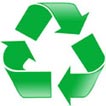Recycling Facts for Kids
Enjoy a wide range of
fun recycling facts for kids. Learn more about the recycling process so
you know what’s happening next time you leave out your old plastic
bottles and aluminum cans to be picked up by curbside recyclers.
|
- Reduce, Reuse, Recycle.
A wide variety of different materials can be recycled, including paper, plastic, glass, metal, textiles and electronic equipment.
The idea of recycling
isn’t something new, historical evidence shows that humans have been
recycling various materials for thousands of years.
There are different
methods of waste collection. These include drop off centers (where
waste materials are dropped off at a specified location), buy back
centers (where certain materials are exchanged for money), and curbside
collection (where recycling vehicles are used to pick up waste
material intended for recycling along residential streets).
Powerful magnets are used to sort through different types of metals.
Recycled paper can be
made from three different types of paper; mill broke (paper scrap and
trimmings), pre-consumer waste (paper that was discarded before
consumer use), and post-consumer waste (paper discarded after consumer
use, such as old newspapers).
Recycling plastic can be
more difficult than other materials and plastics are not typically
recycled into the same type of plastic.
Different types of
plastics are labeled by numbers (plastic identification code), for
example polyethylene (PET) is number 1 and polyvinyl chloride (PVC) is
number 3.
Recycling old aluminum uses only 5% of the energy used to make new aluminum.
Aluminum can be recycled from cans, bicycles, computers, cookware, wires, cars, planes and other sources.
Glass recycling is often separated into colors because glass keeps its color after recycling.
For every ton of
recycled glass turned into new products, 315 kilograms of extra carbon
dioxide that would have been released during the creation of new glass
are saved.


Δεν υπάρχουν σχόλια:
Δημοσίευση σχολίου